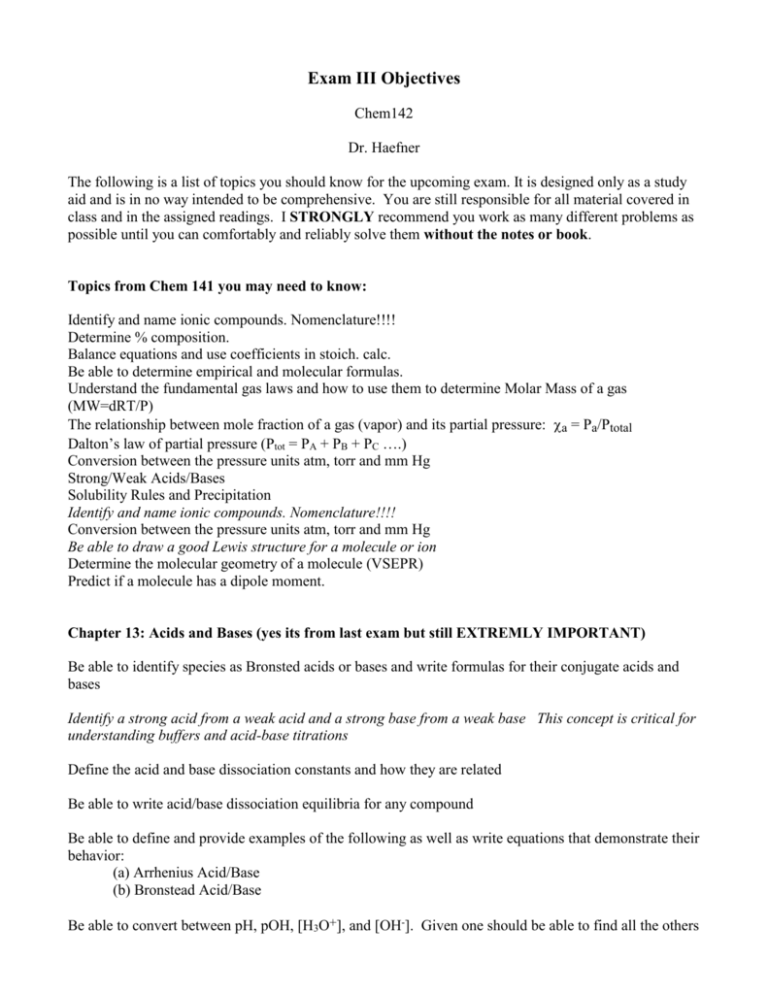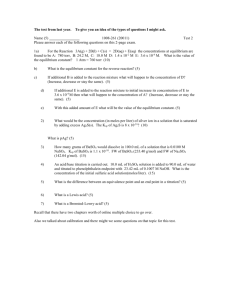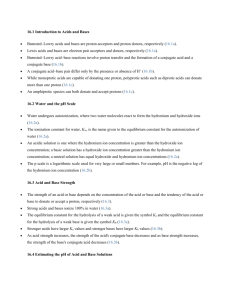Chem 111 Exam 2 Review Sheet
advertisement

Exam III Objectives Chem142 Dr. Haefner The following is a list of topics you should know for the upcoming exam. It is designed only as a study aid and is in no way intended to be comprehensive. You are still responsible for all material covered in class and in the assigned readings. I STRONGLY recommend you work as many different problems as possible until you can comfortably and reliably solve them without the notes or book. Topics from Chem 141 you may need to know: Identify and name ionic compounds. Nomenclature!!!! Determine % composition. Balance equations and use coefficients in stoich. calc. Be able to determine empirical and molecular formulas. Understand the fundamental gas laws and how to use them to determine Molar Mass of a gas (MW=dRT/P) The relationship between mole fraction of a gas (vapor) and its partial pressure: a = Pa/Ptotal Dalton’s law of partial pressure (Ptot = PA + PB + PC ….) Conversion between the pressure units atm, torr and mm Hg Strong/Weak Acids/Bases Solubility Rules and Precipitation Identify and name ionic compounds. Nomenclature!!!! Conversion between the pressure units atm, torr and mm Hg Be able to draw a good Lewis structure for a molecule or ion Determine the molecular geometry of a molecule (VSEPR) Predict if a molecule has a dipole moment. Chapter 13: Acids and Bases (yes its from last exam but still EXTREMLY IMPORTANT) Be able to identify species as Bronsted acids or bases and write formulas for their conjugate acids and bases Identify a strong acid from a weak acid and a strong base from a weak base This concept is critical for understanding buffers and acid-base titrations Define the acid and base dissociation constants and how they are related Be able to write acid/base dissociation equilibria for any compound Be able to define and provide examples of the following as well as write equations that demonstrate their behavior: (a) Arrhenius Acid/Base (b) Bronstead Acid/Base Be able to convert between pH, pOH, [H3O+], and [OH-]. Given one should be able to find all the others Understand the relationship between Ka and Kb for a conjugate acid/base pair (Ka x Kb = Kw) Be able to calculate the pH and pOH for any solution: (i) Strong acid present (ii) Strong base present (iii) Weak acid ONLY (iv) Weak base ONLY (v) Weak Acid/Base Conjugate pairs (Buffers) a. Write out majors species b. Identify them as SA, SB, WA, WB or SI c. Look for stoichiometric reactions (i) SA + SB (ii) SA + WB (iii) WA + SB Carry out stoichiometric reactions using MOLES, one of the species must go to 0 moles at the end of the reaction. d. After reaction (if any) identify new Major species and their new concentrations e. Find pH based on what species are present Be able to calculate the percent ionization of an acid or base Be able to calculate acid or base concentration from pH given Ka or Kb Be able to calculate Ka or Kb from pH info Be able to find pKa and pKb from Ka and Kb. Be able dentify whether an ion will produce an acidic, basic or neutral solution and write the proper equilibrium that accounts for its behavior Be able to identify an acid or base dissociation equilibrium reaction and its associated equilibrium constant Ka or Kb. Be able to identify whether a salt will produce an acidic, basic or neutral solution when dissolved in water Be able to predict the relative acidity/basicity of various species Be able to identify and define an amphoteric species Be able to identify and write reactions that correspond to the acid/base behavior of binary oxides Be able to order solutions (with out calculations) according to pH, pOH, acidity, and basicity Be able to write an equilibrium equation that illustrates how a transition metal ion behaves as an acid in aqueous solution Be able to predict acid and base strength based upon structure (note that we only learned how to predict acid strength but we can apply the fact that a stronger acid has a less basic conjugate base) Be able to use resonance structures to explain acid/base behavior Be able to order a series of compounds with respect to their pH. Be able to predict whether an oxide will produce an acidic or basic aqueous solution and write a balanced equation Understand how resonance structures affect the stability of conjugate bases and therefore acid strength. Identify which species may behave as Lewis acids and Lewis bases. Be able to identify a lewis acid/base reaction Chapter 14: Applications of Acid/Base Equilibria Be able to identify a buffer solution Be able to choose chemicals and amounts needed to make a buffer of a particular pH. Three methods: (a) approx 1:1 mixture of HA and A(b) partial neutralization (approx 1/2 way to the eq. pt.) of a weak acid (HA) with a strong base (OH) (c) partial neutralization (approx 1/2 way to the eq. pt.) of a weak base (A-) with a strong acid (H3O+) Be able to identify what range of pH's a buffer will operate. Be able to describe how and why a buffer works as well as the importance of the ratio [A-]/[HA] Be able to calculate the pH of a buffer solution. Be able to determine the equilibrium constant for a neutralization reaction Be able to calculate the pH of a buffer solution following addition of a strong acid or base. Treat as 2 step problem; step 1 is a neutralization reaction that goes to completion, step 2 is an equilibrium problem involving the remaining weak acid or base present Be able to describe what an indicator is, how it works and which one to choose for a particular titration Titrations: I. II. III. Strong acid - Strong base Weak acid - Strong base Weak base - Strong acid Be able to draw titration curves for each type of titration . Be able to identify specific regions of interest, i.e. equivalence point, buffer region, where pH = pKa. Be able to identify what the major species are in solution at each point along the titration Be able to write out the acid/base neutralization reaction and determine their equilibrium constant Be able identify whether the solution is acidic, basic or neutral at its equivalence point and explain why (without any calculations!) Be able to determine the pH at any point along the titration curve. The exact method will depend on what major species are present. Chapt. 15: Complex ions (SKIP) Be able to write the formula for an aqueous transition metal ion Be able to describe Metal-ligand bonding as a Lewis-Acid/Base interaction Be able to predict based on its Lewis structure, if a molecule may act as a ligand Be able to define a polydentate ligand Be able to determine the metal oxidation state of a coordination compound Be able to determine the coordination number of a coordination compound Be able to write a chemical reaction expressed by Kf Be able to use Kf to predict the relative stability of a complex ion Be able to show how complex ion formation can increase the solubility of a substance (combine individual equilibrium reactions for Ksp and Kf) Be able to find equilibrium concentrations of a species using Kf (application of equilibrium) Be able to determine Kf given equilibrium concentrations (application of equilibrium) Chapt 16: (No Ksp Calculations on Exam III) Be able to write the chemical equilibrium corresponding to Ksp Be able to determine the solubility of a compound (skip) Be able to calculate the Ksp of a saturated solution (skip) Be able to predict whether a salt will precipitate given the concentration of its ions in solution (Compare Q to Ksp) (skip) Be able to predict how addition of the following will affect the solubility of a compound (application of Le Chatlier) (skip) (i) common ions (ii) changes in pH or presence of an acid/base (iii) complex ion formation Use your homework assignments and quizzes as a guide to the types of problems that may appear. For additional practice problems, try the suggested practice problems from the text. The answers to these are located in the back so you can check your results. The key to doing well is to work as many problems as possible. Practice really does make perfect here. However, be aware that you may encounter a problem that you have not seen before. If so, think about the problem and extrapolate what you do know to the problem. Don't just memorize the mechanics of doing a certain type of problem but understand the principles and fundamental concept behind the problem. If you simply memorize mechanics, you will not do well. By exam time you must be able to work all problems independently, quickly and correctly. Don't rely on your notes while practicing these problems. When working problems under test conditions, make note of any doubts have or guesses that you make when solving problems. If you question yourself about what to do, this is a weakness that you need to work on. Keep in mind that we haven't yet determined over 50% of the total points possible. This means that if you performed below your expectations so far, you still have an excellent opportunity to do well. But it is up to you! I will be available as much as possible the week before the exam. If you have questions please come in and ask. Use your homework assignments and quizzes as a guide to the types of problems that may appear. However, be aware that you may encounter a problem that you have not seen before. If so, think about the problem and extrapolate what you do know to the problem. Don't just memorize the mechanics of doing a certain type of problem but understand the principles and fundamental concept behind the problem. If you simply memorize problems, you will not do well. Useful Constants and Equations Planck's constant Speed of light Atomic mass unit Boltzmann constant Gas Constant Faraday h = 6.626 x 10-34 J•s c = 2.9979 x 108 m/s amu = 1.66054 x 10-27 kg k = 1.38066 x 10-23 J / K R = 8.31451 J / K R = 0.08206 L • atm / K mol F = 96,485 C/mole e- Kf [Ag(NH3)2]+ = 1.7 x 107 Enthalpy of vaporization for H2O Enthalpy of fusion for H2O 40.7 KJ / mol 6.02 KJ / mol E = 2.31 x 10-19 J • nm (q1 q2 / r) zero order: [A] = -kt + [A]0; t1/2 = [A]0/2k (KE)avg = 3/2 RT first order: ln [A] = -kt + ln [A]0; t1/2 = ln 2/k urms = (3RT / M)1/2 second order: [A]-1 = kt + [A]-1; t1/2 = 1/k[A]0 ln(P1/P2) = H/R (1/T2 – 1/T1) k = Ae-Ea/RT sc: l = 2r; ln(k2/k1) = Ea/R (1/T1 – 1/T2) bcc: l = 4r / (3)1/2 T = i K m fcc l = r (8)1/2 =iMRT G = H - TS -b ± b2 - 4ac x= 2a G = G° + RTlnQ ln(K2/K1) = /R (1/T1 – 1/T2) = ° - (RT/nF)lnQ = ° - (0.0592/n)logQ E = mc2 E = h = c PMm = dRT






